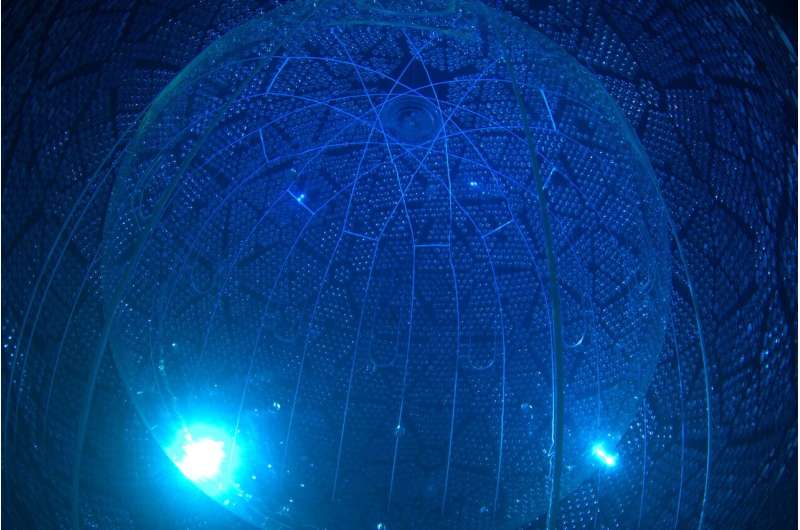April 11, 2023 feature
This article has been reviewed according to Science X's editorial process and policies. Editors have highlighted the following attributes while ensuring the content's credibility:
fact-checked
peer-reviewed publication
trusted source
proofread
The SNO+ collaboration gathers the first evidence of antineutrinos in a water Cherenkov detector

Antineutrinos, the antimatter counterpart of neutrinos, have an almost non-existent mass and charge, and almost never interact with other particles, which makes them particularly difficult to detect. Physicists have been studying neutrinos from reactors for many years, typically using scintillator-based detectors.
These efforts led to significant physics discoveries, from the first detection of neutrinos in the late 1950s to recent measurements of neutrino oscillation parameters. As neutrinos hardly interact with other particles, they are generally hard to detect. Neutrinos produced in nuclear reactors are detected through the so-called inverse beta decay (IBD). This is a signal produced during nuclear reactions, which involve an electron antineutrino with a proton, producing a positron and a neutron.
The SNO+ experiment, a large-scale research effort collecting data using the multipurpose particle detector at SNOLAB, recently gathered the first evidence of reactor antineutrinos inside a water Cherenkov detector (i.e., a type of particle detector that detects radiation and reconstructs information about particles). Their paper, published in Physical Review Letters, could pave the way for new antineutrino searches using water Cherenkov detectors.
"The primary goal of the SNO+ experiment is to conduct a high-sensitivity search for neutrinoless double beta decay using a tellurium-loaded liquid scintillator," Logan Lebanowski told Phys.org on behalf of the SNO+ collaboration. "With the detector currently filled with scintillator, SNO+ is also measuring the neutrino mass splitting ?m221 using reactor antineutrinos. Prior to this, the collaboration filled the detector with water to calibrate detector components and characterize intrinsic radioactive backgrounds."
Given that the SNO+ detector has a good enough sensitivity to measure reactor antineutrinos with a liquid scintillator, the SNO+ collaboration set out to explore the possibility that antineutrinos could also be observed using water. The detector also has the lowest reported rates of background-inducing muons from the atmosphere among water Cherenkov detectors, which significantly improved the team's chances of detecting antineutrinos.
The SNO+ detector is a large acrylic vessel, measuring 12m in diameter. At the time of the experiment, it was filled with ultra-pure water.
"This provides a large volume for particles coming in to interact and produce light," Christine Kraus explained. "This light then can be recognized by Photomultipliers, we have ~9500 surrounding the acrylic vessel mounted on a steel structure. Photomultipliers convert the signal into an electrical one that can be processed. We then can determine energy and position of the event."
When trying to detect antineutrinos from reactors, physicists are essentially searching for a unique signal known as "coincidence signal," which clearly indicates the presence of anti-neutrinos. Kraus and the rest of the SNO+ collaboration specifically searched for this signal in data collected during a period of 190 days. To extract the signal, they conducted two independent analyses, which yielded consistent results.
"This worked for us—a first in a water detector—because our neutron detection efficiency is high," Lebanowski said. "The neutron produced in an IBD captures on hydrogen in the water and produces a 2.2-MeV ?, regardless of the energy of the incident antineutrino. Therefore, the achievement of detecting the 2.2-MeV ? with higher efficiency can impact a broad range of antineutrino searches and measurements made with pure water Cherenkov detectors."
The SNO+ collaboration was the first to detect antineutrinos in a water Cherenkov detector. They achieved this using ultra-pure water and minimizing natural radioactivity in the detector, which can produce confounding background events resembling the coincidence signal they were looking for. In the future, the result of this study and the methods employed by the SNO+ collaboration could inform additional antineutrino searches and measurements using pure water Cherenkov detectors.
"Observing reactor antineutrinos with pure water demonstrates that reactor antineutrinos can be observed with a target medium that is non-toxic, safe, easy to handle, and cheap, and therefore favorable for use anywhere and when desiring a large target," Lebanowski said. "This analysis also demonstrates the ability of water Cherenkov detectors to make measurements at lower energies, and a strong ability to distinguish the signal from the radioactive backgrounds present in most detectors."
A key reason why Cherenkov detectors can distinguish coincidence signals from unrelated background signals is that they provide an estimated direction for incident particles. This has not yet been achieved using scintillator detectors, which will be an area of focus for the SNO+ collaboration's future research.
"With the liquid scintillator we expect to have an even better signal for anti-neutrinos, not just from reactors but also from the natural radioactivity in the Earth itself—so-called geo-neutrinos," Kraus added. "They have been measured twice before—first in Japan by the KAMLAND experiment and then in Europe by the Borexino experiment. We would be the first in North America and being located in the Canadian shield is interesting, because the structure is different from the two other locations."
More information: A. Allega et al, Evidence of antineutrinos from distant reactors using pure water at SNO+, Physical Review Letters(2023). DOI: 10.1103/PhysRevLett.130.091801
Journal information: Physical Review Letters
© 2023 Science X Network





















